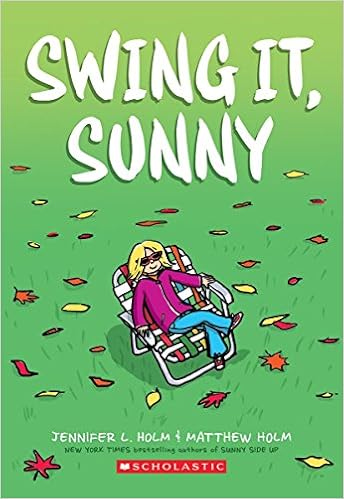 Swing It Sunny
Swing It SunnyJennifer & Matthew Holm
Scholastic, September, 2017 218 pages
Grades 4-Up
Graphic Novel
Sunny, heroine of the smash-hit semi-autobiographical graphic novel Sunny Side Up, must begin middle school. Older brother, Dale, who we first meet in the previous title, is still struggling with substance abuse. His parents out of desperation send him away to military school in the hope of straightening him out. Sunny continues to feel sad, angry, and guilty about her brother's addictive behavior and is trying to process these feelings, all while attempting to adjust to the new school environment and life as a budding teenager. As 1976 changes to 1977 Sunny spends time with her best friend watching television, bonding with her baby brother, and confessing her feelings to her grandfather in Florida. A visit home from Dale is disappointing and only when an older new neighbor moves in and befriends Sunny does she start to feel hopeful. Through the neighbor Sunny learns how to twirl color guard flags and discovers that she is good at it. Through the passing of time, the acceptance and friendship of her new neighbor, and her success in learning a new skill, Sunny starts to heal and let go of the feelings of responsibility and constant sadness brought on by Dale. By the school year's end Sunny has grown in confidence and maturity and Dale seems a bit less angry and maybe willing to try to mend his broken relationship with his family.
Sunny Side Up is one of my favorite graphic novels. I can relate to both the 1970's setting and dealing with a brother who is an alcoholic. Sunny and I are the same age and have very parallel childhoods, so of course I love this book. I have asked kids at my library and in book discussion if they can relate to Sunny and am always greeted with a resounding "yes". Sunny's troubles are universal and, unfortunately, still relatable to today's youth. This sequel takes place directly where the first installment ends and traces Sunny's school year. It does not break new ground; the same themes hold true with no new earth-shattering developments. If anything, the 1970's setting is delved into deeper, focusing more on the music and television shows we all watched for hours at a time. Dale does not magically get "fixed", but we do see hope by book's end. Readers in similar situations will gain from watching Sunny come to terms with Dale's condition with the help of family members and learn to let go of some of the negative feelings she is holding onto and find positive feelings from within herself and a new confidence thanks to an acquired skill. Much like the first novel, the cartoons are well drawn, expressive, are in full-color and scan easily. Knowledge of the first book would making reading the second a richer experience, but enough background is given, allowing it to stand alone. A slam-dunk for fans of Sunny Side Up and for readers of the current trend of realistic graphic novels pioneered by Raina Telgemeier.
No comments:
Post a Comment